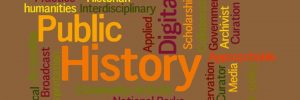
Today’s topic lies on reviewing public history websites. In the light of Paula Petrik’s conceptions of web design and Daniel Cohen and Roy Rosenzweig’s ideas on digital history, I chose to review the following two websites: the international Public History Weekly and the outdated http://www.publichistory.org/.
As an international website, the Public History Weekly have a established frontpage with a solid and useful top menu that describes the main subjects necessary to navigate. As one of the main issues for a website, the contrast between fonts and background appears clear and completely readable. There is a plain background and a simple pattern of fonts organized throughout the website. With a design like that, the user have better chances of not getting tired of reading the material posted on it. On the other side, a negative aspect of the frontpage lies on the amount of information provided side by side.
Although the site makes an effort to arrange into separate blocks of text and not mix everything, by uploading different kinds of information all in the same space makes a little bit confusing to read the first page. However, in the general the website is quite well organized and designed. With diversified theoretical and non-theoretical information distributed in all the buttons. Although I understand that this website is a blogjournal I would encourage them into adding multimedia platforms and incorporating things such as youtube videos and interactive timelines.
One important aspect: Most of the articles are short. Nowadays, most of the public do not stay long in one website reading long texts. Thus, it fits well a Public History website having short essays with quality on it.
The curious situation of this website is the fact that if you access it through the above URL you probably will not be able to find it. So you might even think that the webpage does not exist. However if you try in a different way such as using this link here http://www.publichistory.org/what_is/definition.html, then you are going to stumble upon all the information that they want to expose. Or maybe part of it. The website is definitely outdated, as you can see 5 out of the 7 buttons on the top menu does not function. The website started in 1999 and stopped being updated in 2010.
Still, they have a couple of interesting sections in which they discuss different descriptions and definitions of Public History, and how to evaluate history websites. In fact, to debate digital public history, the website suggests the reading of Debra DeRuyver and Jennifer Evan’s article from 2006 named Digital Junction. Talking about the design of the website, I would say that for a such old page, it is quite organized and it works fine if you just want to read text and nothing more. But that’s pretty much it, the website is quite dead and there is almost nothing of information there.

Reading the post of my colleagues is an extremely useful tool, as it challenges me to engage with elements of websites that may not be on my radar and/or could simply take for granted. While I’ve spent time focusing primarily on design layout; font, size & color choice; and usability/navigation, I’ve seem to completely overlook the value of organization.
Given my interest in personal narratives and narrative construction, organization is a central component. Websites tell a story and while the information presented may be comprehensive, that doesn’t necessarily mean that it flows or provides direction for the story. Reading Yuri’s post and reviewing the sites he examined has made website organization a priority, especially because I want to tell a story that flows, rather than one this disjointed.
I like that he provides a recommendation of things that could enhance the sites but one thing that I would recommend is thinking critically about the need for digital technologies on all website. Should all site incorporate digital technology, if so, why/why not.?
Good call singling out the various dichotomies and classifications we can use to understand how to organize our menus. There may often be an “obvious” choice for how to arrange the material, but it is always worth thinking about your diverse users (e.g., the user who wants to distinguish between theoretical and pragmatic information, as you mention). What will they bring to the table and can we accommodate them as they experience our spaces?